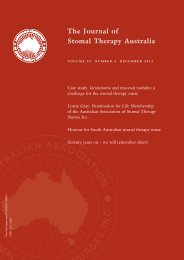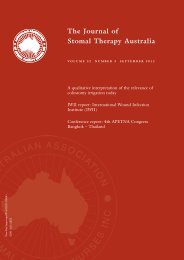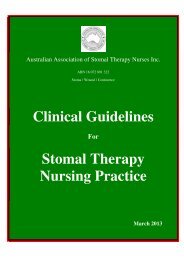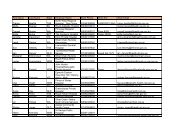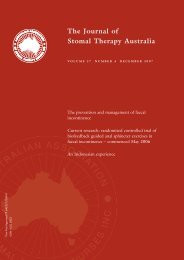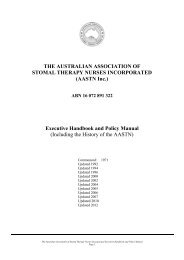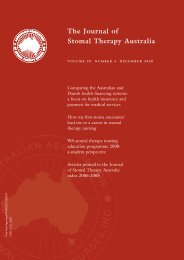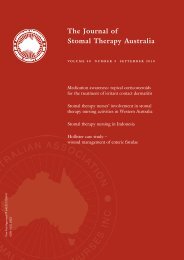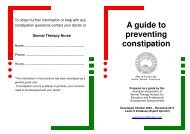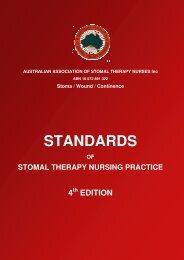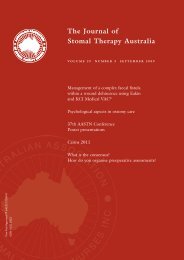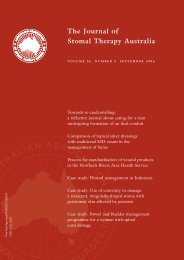JSTA December 2010 - Australian Association of Stomal Therapy ...
JSTA December 2010 - Australian Association of Stomal Therapy ...
JSTA December 2010 - Australian Association of Stomal Therapy ...
Create successful ePaper yourself
Turn your PDF publications into a flip-book with our unique Google optimized e-Paper software.
achieve the desired patient outcomes without costing the patient<br />
any money. Of course, in many cases compromises had to be<br />
made so teaching principles became important.<br />
Figure 4. Modified parcel dressing.<br />
This young man had been an IV injecting drug user. The wound<br />
was a result <strong>of</strong> debridement <strong>of</strong> a necrotic and infected groin, his<br />
Stage 4 wound is in a difficult position adjacent to his scrotum.<br />
Within the wound bed are two ligated blood vessels which<br />
need protection. Students doing the programme were unused<br />
to having to touch male genitals to provide effective wound<br />
management.<br />
Other types <strong>of</strong> wounds encountered during the clinical<br />
practice included large pressure ulcers, fungating tumours,<br />
acute traumatic wounds, Fournier’s gangrene, compartment<br />
syndrome, numerous diabetic foot wounds, fistulas and draining<br />
wounds.<br />
Figure 5. Stage 5 pressure ulcer.<br />
28 Journal <strong>of</strong> <strong>Stomal</strong> therapy australia – Volume 30 Number 4<br />
This poor, quadriplegic lady had pressure ulcers all over her<br />
body in addition to ischaemic lesions on her lower limbs. Her<br />
husband was her primary carer in the hospital and used to<br />
get up on to the bed and turn her by himself. The bed had no<br />
mechanism to raise or lower it and a pressure-relieving mattress<br />
was unheard <strong>of</strong>. Patients all require a ‘sitter’ to care for them.<br />
These sitters do most <strong>of</strong> the tasks we would consider to be<br />
nursing, including performing basic hygiene, feeding, changing<br />
bed linen and obtaining medications from the pharmacy. They<br />
may also be required to do wound dressings and carry out<br />
stoma care.<br />
Figure 6. Diabetic foot ulcer following surgical debridement.<br />
Students had plenty <strong>of</strong> exposure to lower limb ulcers. There<br />
were numerous patients with diabetes and vascular lesions. The<br />
students were fortunate to have Keryln Carville running the<br />
debriding, lower limb assessment and compression bandaging<br />
workshops which they all participated in. There was plenty <strong>of</strong><br />
opportunity for the students to develop and hone their skills.<br />
Figure 7. Debriding workshop using lambs’ feet instead <strong>of</strong> pigs’ trotters.



